This article was medically reviewed by Luba Lee, FNP-BC, MS. Luba Lee, FNP-BC is a Board-Certified Family Nurse Practitioner (FNP) and educator in Tennessee with over a decade of clinical experience. Luba has certifications in Pediatric Advanced Life Support (PALS), Emergency Medicine, Advanced Cardiac Life Support (ACLS), Team Building, and Critical Care Nursing. She received her Master of Science in Nursing (MSN) from the University of Tennessee in 2006.
There are 9 references cited in this article, which can be found at the bottom of the page.
This article has been viewed 66,812 times.
If you're suffering from a surgical procedure or injury to your upper body, you might need to wear a sling to facilitate the healing process. Your doctor will probably help you put it on initially, but you will be responsible for removing it, adjusting it, and putting it back on. Working your sling can be a bit tricky, but like most things, it becomes much simpler with a bit of practice and some minor adjustments!
Steps
Assembly
-
1Gather all of your sling materials. The first strap is the waist immobilization strap that wraps around your waist. The second is the shoulder strap, which is distinguished by the presence of a neck/shoulder pad that makes it more comfortable to wear. Both straps should have Velcro on one side and a smooth surface on the other. Finally, you have your sling envelope, which wraps around your forearm.[1]
- Check that each sling has 4 clips in total: 2 round and 2 thin.
-
2Hold the sling envelope in front of you with the front facing away from your injured arm. Make sure the rings are closer to your wrist and the string-shaped clips are closer to your elbow. For example, if you're wearing the sling on your left arm, the 2 string-shaped clips should be on the left and the round ones should be on the right.[2]
- If you're attaching the sling to your right arm, the 2 string-shaped clips should be to the right and the round ones should be on the left.
Advertisement -
3Attach the waist immobilization strap through the lower string-shaped clip. Hold the strap so the Velcro is facing upward. With your other hand, hold the lower string-shaped clip and begin threading the strap through it. Feed about 2 inches (5.1 cm) of it through the clip, fold it back it over onto itself, and attach it to the Velcro.[3]
- Make sure the bowed end of the string-shaped clip is facing upward.
-
4Attach the shoulder strap through the top string-shaped clip. Again, hold the strap with the Velcro facing upward. Use your other hand to hold the sling in front of you. Feed about 2 inches (5.1 cm) of the strap through the clip, taking care to feed it away from the elbow. Afterward, fold it back on itself and attach it to Velcro.[4]
- Be sure that the Velcro is on the outside facing away from your body when you wrap the strap across your shoulder.
How to Wear
-
1Hold the sling in your free hand and thread your injured arm through the sling gap. Grasp the sling by the round clip at the top of the sling with your non-injured hand. Make sure that the bottom of the sling is facing outwards. Gently put your hand through the sling until it extends from the gap at the other end and rest your wrist on the end of the sling.[5]
- To hold your position before moving on to the next step, place the thumb of your injured hand through the round clip in your non-injured hand and press it against your chest.
-
2Pull the sling over your elbow and arm with your non-injured hand. Make sure that your hand reaches the end of the sling but doesn't dangle over it. If the sling only reaches your wrist, it's likely too small.[6]
- Take care that the end of the sling doesn't dig into your hand or wrist.
-
3Wrap the shoulder strap across your injured shoulder and over your neck. Use your non-injured hand to grab the shoulder strap and pull it upward to bring the sling envelope onto the elbow. Now, wrap the shoulder strap across your injured shoulder and over your non-injured shoulder beside your neck so it hangs from your chest.[7]
- Make sure that the Velcro is facing outward away from you.
-
4Connect the shoulder strap to the sling envelope via the top ring. Thread the strap through the top ring and double the Velcro back on itself so it's secure. Make sure that the top of the free end of the strap connects to the Velcro at neck-level.
- If the sling feels too tight, remove the Velcro, readjust your arm position, and reattach it.
-
5Attach the immobilization strap to the remaining ring. Wrap your non-injured hand behind your back and grab the immobilization strap hanging from the back of the sling envelope. Pull it around your waist like a belt, thread it through the remaining ring, and double it back onto itself to connect it to the Velcro.[8]
-
6Place your thumb into the loop that hangs beneath the shoulder strap. The thumb loop is typically connected to the sling envelope. It is likely directly underneath the region where the shoulder strap connects to the envelope.
- Use the thumb loop to prevent your arm from moving out of position and keep your hand neutral.
Adjustments
-
1Tighten your sling when your arm frequently moves out of place. If your sling is too loose, your arm will likely not feel secure and might even hang down. To tighten your sling, remove the Velcro strap from your non-injured shoulder and attach it further up. Make sure your arm and forearm are always supported.[9]
- Always keep your sling tight enough that your forearm and hand are elevated slightly above your elbow. This promotes healthy circulation and prevents swelling in your hand.
-
2Loosen your sling if you experience numbness or tingling in your forearm. When your sling is too tight, it restricts blood flow to and from your hand and elbow. To loosen your sling, remove the Velcro strap from your non-injured shoulder and attach it further down your chest.[10]
- Contact your doctor or physical therapist if you experience recurring symptoms of tingling and numbness.
-
3Adjust your shoulder sling if your arm is hanging too low. When your arm hangs too low, the weight of it can place strain on your arm and its shoulder. Not only that, it can come loose unexpectedly. Remove the Velcro strap from your non-injured shoulder and move it up and down until your elbow is bent 90 degrees and your forearm and hand are slightly above your elbow.[11]
- Make sure your arm is supported without lifting and that your shoulder is never dropped or lifted.
- Smooth out your sling so that there are no uncomfortable pressure points or wrinkles between your arm and sling material to prevent sore spots on your skin.
References
- ↑ https://www.dgft.nhs.uk/wp-content/uploads/2021/01/Slings-and-wrist-splints-V3.pdf
- ↑ https://youtu.be/-x6MIQE8Whs?t=261
- ↑ https://youtu.be/-x6MIQE8Whs?t=246
- ↑ https://youtu.be/-x6MIQE8Whs?t=295
- ↑ https://youtu.be/-x6MIQE8Whs?t=329
- ↑ https://myhealth.alberta.ca/health/Pages/conditions.aspx?hwid=zm6169&lang=en-ca
- ↑ https://www.ortho.wustl.edu/content/Patient-Care/3416/Services/Shoulder-Elbow/Overview/Rotator-Cuff/Postoperative-Care.aspx
- ↑ https://www.ortho.wustl.edu/content/Patient-Care/3416/Services/Shoulder-Elbow/Overview/Rotator-Cuff/Postoperative-Care.aspx
- ↑ https://myhealth.alberta.ca/health/Pages/conditions.aspx?hwid=zm6169&lang=en-ca
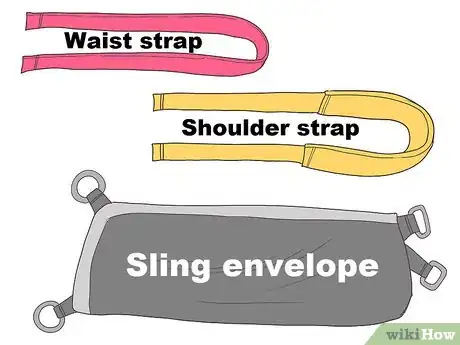
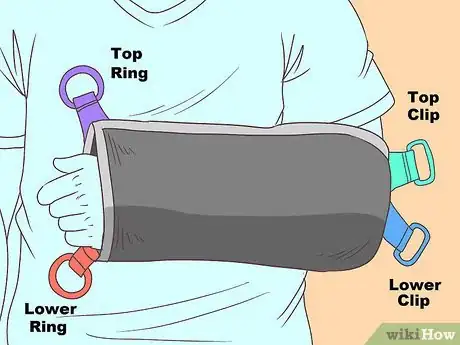
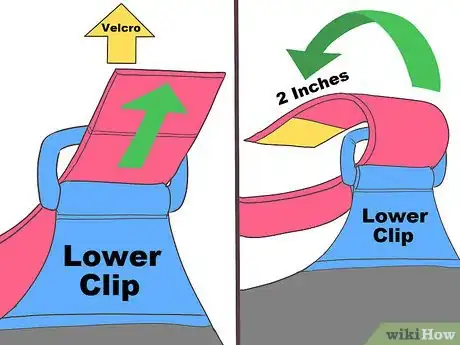

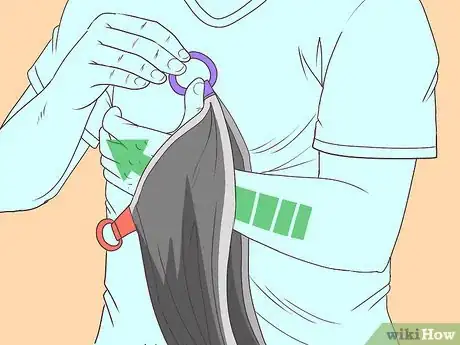


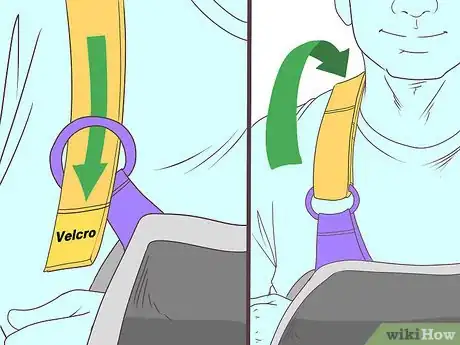

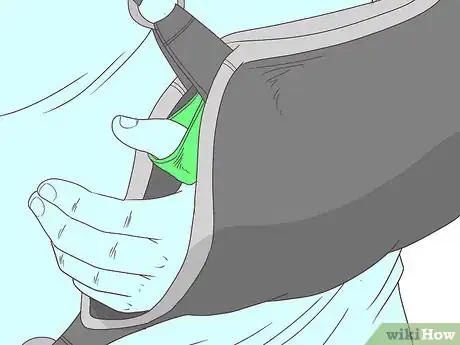
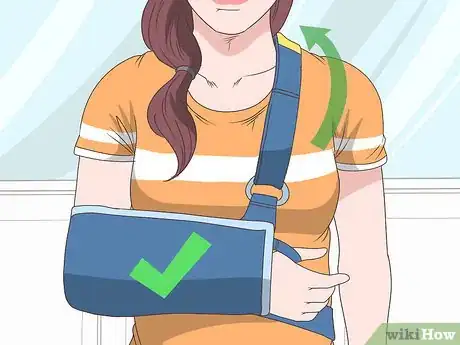
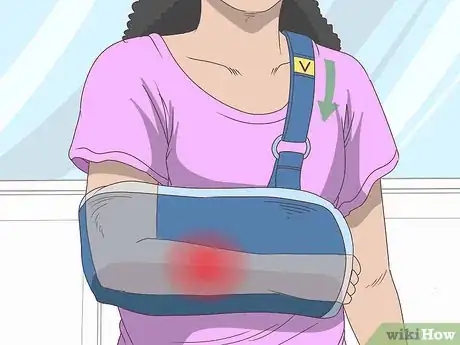
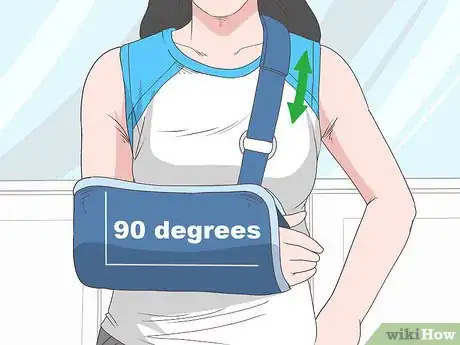




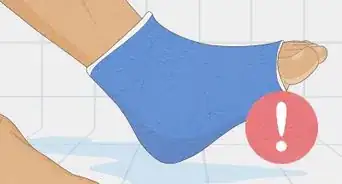

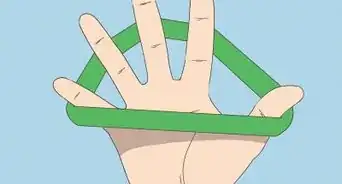

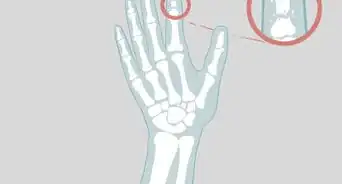


















































Medical Disclaimer
The content of this article is not intended to be a substitute for professional medical advice, examination, diagnosis, or treatment. You should always contact your doctor or other qualified healthcare professional before starting, changing, or stopping any kind of health treatment.
Read More...